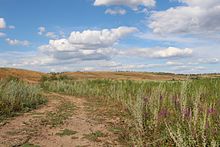Steppe
The steppe (from French: steppe, and eastern Russian: степь, step, AFI: sʲtʲepʲ) is a biome that It consists of a territory of herbaceous vegetation, typical of extreme climates and low rainfall. It is also associated with a cold semi-desert, to establish a difference with the savannahs of hot climates. These regions are far from the sea, with an arid continental climate, a great thermal variation between summer and winter and rainfall that does not reach 500 mm per year. Low grasses and scrub predominate. The soil contains many minerals and little organic matter; There are also steppe areas with a high iron oxide content, which gives the earth a reddish hue.
Locations
Cold Steppe
The largest steppe region in the world, often referred to as "the Great Steppe," is found in Eastern Europe and Central Asia, and neighboring countries stretching from Ukraine in the west through Russia, Kazakhstan, Turkmenistan, and Uzbekistan to the Altai, Koppet Dag, and Tian Shan mountain ranges in China.
Inner Anatolia in Turkey, Central Anatolia and Eastern Anatolia in particular, and also some parts of southeastern Anatolia, as well as much of Armenia and Iran, are largely dominated by cold steppe.
The Pannonian Plain is another steppe region of Central Europe, centered on Hungary but also including parts of Slovakia, Poland, Ukraine, Romania, Serbia, Croatia, Slovenia, and Austria.
Another large steppe (prairie) area is found in the central United States, western Canada, and northern Mexico. The short prairie steppe is the westernmost part of the Great Plains region. The Columbia Plateau, in southern British Columbia, Oregon, Idaho, and Washington state, is an example of a North American steppe region outside of the Great Plains.
In South America, the cold steppe is found in Patagonia and much of the high-elevation region east of the southern Andes.
Relatively small steppe areas can be found in the interior of the South Island of New Zealand.
In Australia, a moderately sized temperate steppe region exists in northern and northwestern Victoria, extending into southern and central New South Wales. This zone borders the semi-arid and arid interior of Australia, which lies further inland on the continent.
Subtropical steppe
In Europe, some Mediterranean areas have steppe-type vegetation, such as central Sicily in Italy, southern Portugal, parts of Greece south of Athens, and central-eastern Spain, especially the southeast coast (around Murcia), and isolated places with adequate humidity due to the effects of the rain shadow, such as Zaragoza.
In Asia, a subtropical steppe can be found in the semi-arid lands bordering the Thar Desert on the Indian subcontinent, as well as much of the Indian subcontinent, including much of the Deccan Plateau, in the shadow of the Western Ghats, and the Badia del Levante.
In Australia, the subtropical steppe lies in a belt that encircles the continent's harsher deserts and around the Musgrave Ranges.
In North America, this environment is typical of transition zones between Mediterranean climate zones and true deserts, such as Reno, Nevada, inland California, and much of West Texas and adjacent parts of Mexico.
Types of steppes
Asian Steppe
The steppes are associated with a semi-arid continental climate characterized by hot summers and cold, dry winters.
Due to the harsh climatic conditions, the steppes are inhabited by a low variety of animal species and herds of herbivores such as horses. There is also a wide variety of rodents and ratites that often migrate in search of water. Animals adapted to this type of biome include: steppe eagle, saiga antelope, bustard, Przewalski's horse, damsel crane, bobac marmot, lesser Spalax mole rat, and Russian tortoise.
The vegetation in this area is xerophytic, that is, plants adapted to the scarcity of water with deep roots. Among the plants are the following: black wormwood, blue spikelet, gagea, crested grass, sedge, buttercup. In Mongolia there are rabbits, foxes and wolves.
North American Steppe
In North America the Great Plains extend from southern Canada to northern Mexico, in the US states of Colorado, Kansas, Montana, Nebraska, New Mexico, North Dakota, Oklahoma, South Dakota, Texas, and Wyoming. They are a type of steppe that is characterized by a less severe climate than that of the Asian steppes.
The North American steppe is inhabited by prairie dogs, American bison, and others.
The vegetation of the North American steppe is dominated by grasslands and low-lying grasses.
Mediterranean Steppe
The areas of the planet with a Mediterranean climate have some areas with characteristics typical of warm steppes. In Europe, some regions around the Mediterranean Sea have a climate and vegetation similar to that of other steppes, such as Sicily (Italy), Los Monegros or La Mancha (Spain). As well as the Magellanic Pampas and the Norte Chico in Chile, they also have a climate similar to that of a steppe.
The temperature varies a lot: the days are very hot and the nights are very cold. Among the typical plants of the Puna is the cardón, a cactus that lasts several days without drinking water. Living beings are adapted to this extreme climate and have fur that insulates them from the heat of the day and the cold of the night. Others, like chinchillas, make caves to protect themselves. There are also birds, such as the rhea of the puna and the condor of the Andes, which are in danger of extinction.
For more information
- Ecology and Conservation of Steppe-land Birds by Manuel B.Morales, Santi Mañosa, Jordi Camprodón, Gerard Bota. International Symposium on Ecology and Conservation of steppe-land birds. Lleida, Spain. December 2004.ISBN 84-87334-99-7 (in English)








